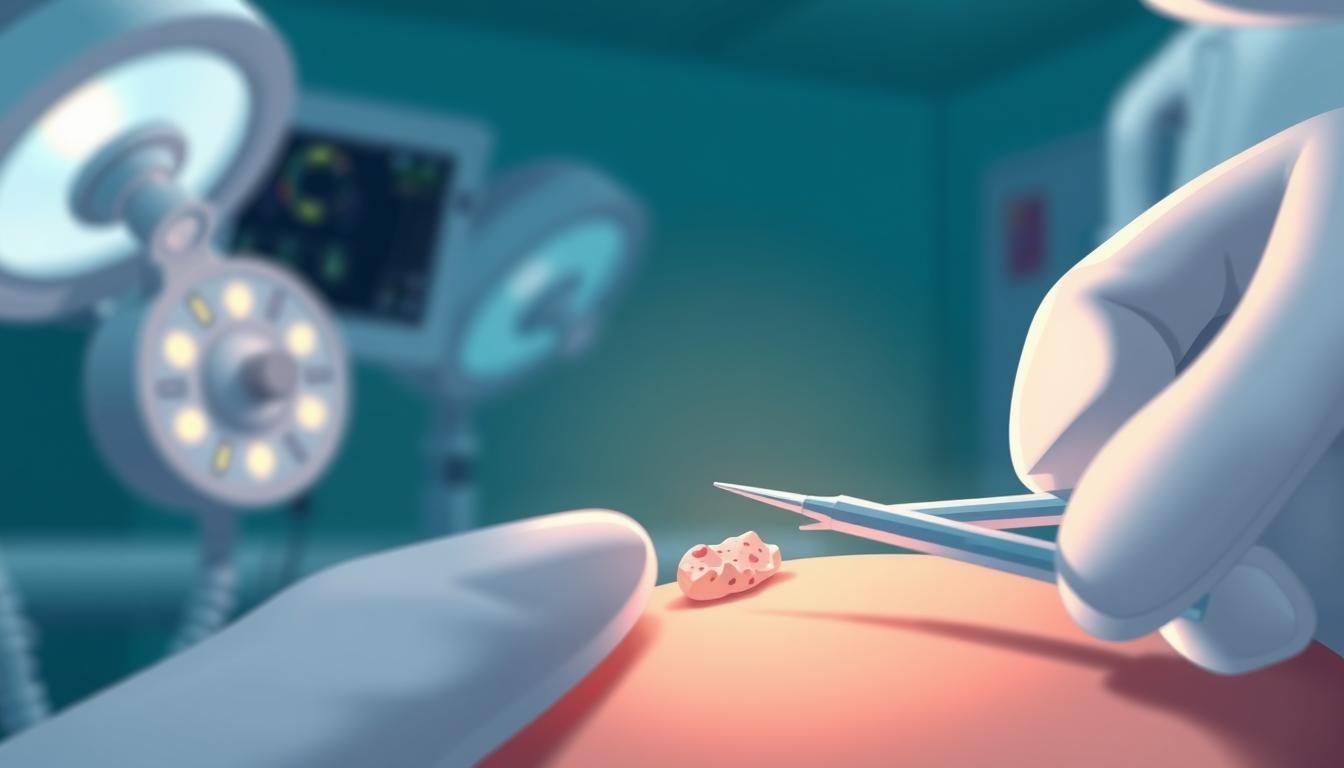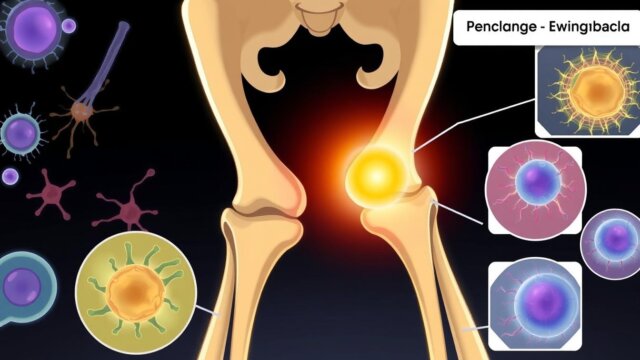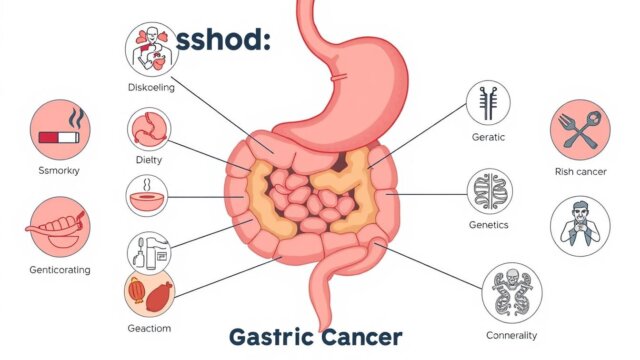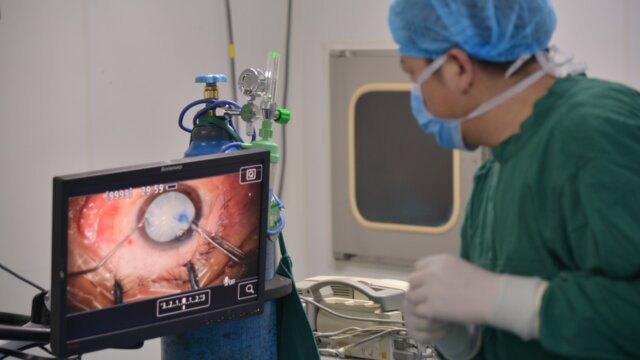FTC disclaimer: This post may contains affiliate links and we will be compensated if you click on a link and make a purchase.
Did you know over 4 million biopsies happen in the United States each year? This important test helps doctors find out what’s wrong with your body. It can spot cancer, find out why you have strange spots, or see why you’re inflamed. Knowing about biopsies can help you make better choices for your health.
In this guide, we’ll explore the world of biopsies and provide the information you need to make an informed decision about this test.
Key Takeaways
- Biopsies are a key tool for doctors to check on many health issues, like cancer, inflammation, and infections.
- Based on what’s wrong, they can be done on different parts of the body, such as the skin, organs, or bone marrow.
- There are many types of biopsies, including needle, endoscopic, and surgical ones. Each has its own method of performing them.
- Getting ready for your biopsy and knowing what to expect can make it go smoothly.
- Biopsy results are very important for determining what’s wrong and how to treat it. Sometimes, more tests or another biopsy are needed to be sure.
What is a Biopsy?
A biopsy is a medical test that involves taking a small piece of body tissue for a microscope check. The term ‘biopsy’ refers to both the act of taking the sample and the tissue itself.
Defining a Biopsy
A biopsy looks for issues like kidney or liver problems or organ swelling. Under the microscope, it can spot abnormal cells, which helps determine the condition you might have.
Reasons for Getting a Biopsy
Biopsies help with many health issues, like cancer, hepatitis, or skin problems. They help doctors know how serious a condition is and what treatment to use.

Biopsies can be done anywhere on the body. They are usually the only way to confirm whether a spot is cancerous.
“Different types of biopsies exist, including punch biopsies, needle biopsies, endoscopic biopsies, excision biopsies, and perioperative biopsies.”
There are many types of biopsies for different health issues, from cancer to inflammation. Knowing about biopsies helps patients understand what to expect.
Types of Biopsy Procedures
Many biopsy procedures are used to obtain tissue samples. Knowing about these can help you prepare for your biopsy.
Needle Biopsies
Needle biopsies use a special needle to get cells or tissue. Fine-needle aspiration (FNA) uses a thin needle to draw out fluid and cells. Core needle biopsy (CNB) uses a bigger needle to get a small piece of tissue.
Image-guided needle biopsies use imaging like CT, MRI, or ultrasound. This helps reach areas that are hard to feel through the skin.
Endoscopic Biopsies
An endoscopic biopsy uses a thin tube called an endoscope. It’s inserted into the body to examine internal structures and obtain tissue samples. This can be done in places like the bladder, lungs, or colon.
Some endoscopic biopsies require a small cut to insert the endoscope. These include laparoscopic, thoracoscopic, and mediastinoscopic procedures.
Surgical Biopsies
Surgical biopsies are more invasive. A surgeon makes an incision to obtain a tissue sample, which can be a small area or the whole lump.
Sentinel lymph node biopsies help figure out cancer stages. Sometimes, a liquid biopsy is used instead of a tissue biopsy.
The type of biopsy depends on the location and size of the area and your health. Your doctor will choose the best one for you.
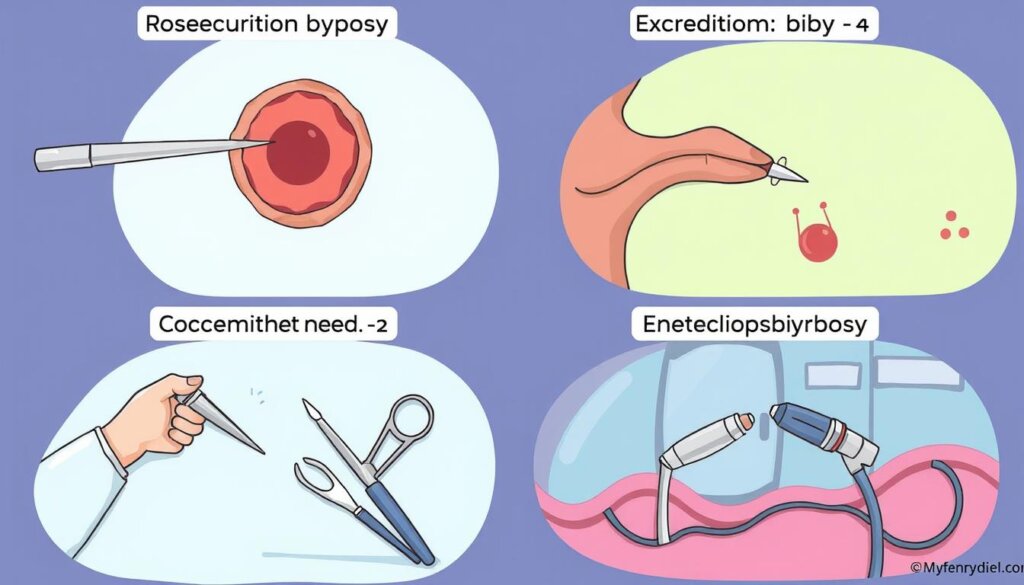
How to Prepare for a Biopsy
Getting ready for a biopsy means following certain steps. These steps help make the test safe and effective. They can change based on the biopsy type and where it’s done.
Your doctor might tell you to stop some medicines before the test, including blood thinners and NSAIDs. This is to lower the chance of bleeding and other problems during the biopsy.
- Tell your doctor about your health issues, past surgeries, and medicines. This helps your team plan the biopsy and keep you safe.
- You might need to not eat or drink certain things before the test.
- Let your doctor know about any allergies or sensitivities. This can affect the medicines used during the biopsy.
Sometimes, you might need tests like CT scans or ultrasounds first. These help guide the biopsy. Your healthcare team will give you all the details you need for your biopsy.

Following your doctor’s instructions can make your biopsy safe and effective. This helps get an accurate diagnosis and the right treatment plan. Talking openly with your healthcare team is important for a good biopsy result.
“Preparation is the key to a successful biopsy. By following the pre-procedure instructions, you can help ensure a safe and accurate diagnosis.”
Biopsy Procedure: What to Expect
Before the Biopsy
You might get a local anesthetic to numb the area before the biopsy. You could also get a sedative to relax you and ease any discomfort or anxiety.
During the Biopsy
Your healthcare provider will use imaging like X-ray or ultrasound to guide the needle. This ensures the right tissue is collected. For some biopsies, like liver or kidney ones, you might need to hold your breath briefly.
The biopsy method can differ depending on the type. Fine-needle aspiration (FNA) biopsies obtain cell samples from organs or lumps. Core needle biopsies (CNB) obtain larger tissue samples. Thicker needles are used for organ biopsies.
Endoscopic biopsies use an endoscope to get tissue samples from the GI tract. Excisional biopsies remove larger tissue areas for study. Perioperative biopsies are done during surgery for quick examination.
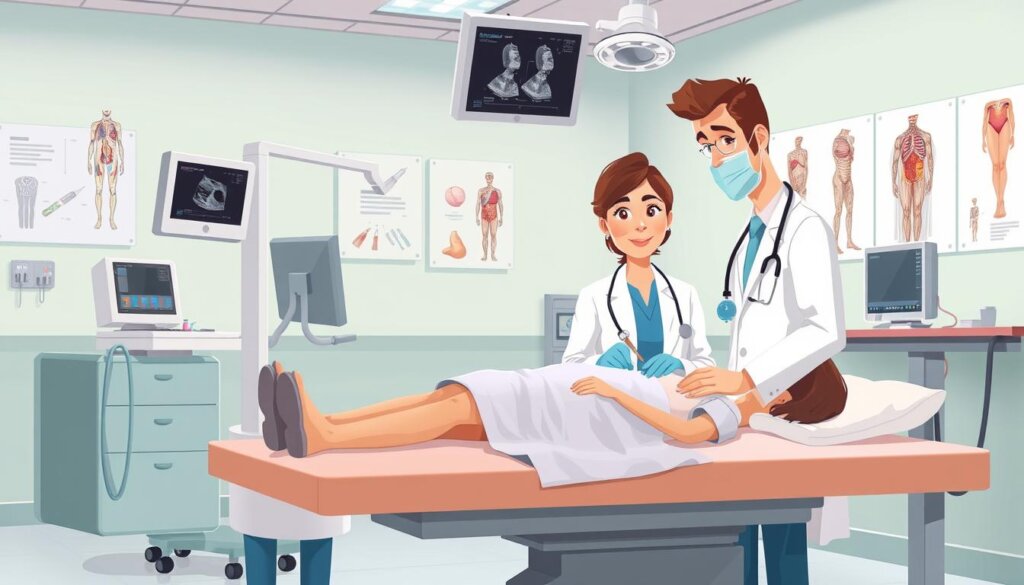
“Most needle biopsies are done on an outpatient basis. They are safe with imaging like ultrasound, CT, or MRI.”
Biopsy Risks and Complications
Biopsies are usually safe, but there are risks and complications. These include bleeding, infection, and pain at the site. Serious problems are rare, but you might feel discomfort or see some bleeding.
Rare complications can be bruising, soreness, small scars, bleeding, or infection at the site. Following your doctor’s advice on caring for the site during recovery is important.
Breast biopsy risks are rare, but they can include infection, bleeding, or scarring. After the procedure, you might feel sore, bruised, or swollen.
- Call the doctor if you have a fever, chills, or drainage from the site.
- It’s crucial to have a follow-up after a biopsy.
Biopsy Type | Potential Complications |
|---|---|
Needle Biopsy | Bleeding, infection, pain, scarring |
Endoscopic Biopsy | Bleeding, infection, perforation of organ |
Surgical Biopsy | Bleeding, infection, pain, scarring, changes in appearance |
Biopsies are key for diagnosing health issues like cancer. It’s vital to know the risks and follow your doctor’s advice. This way, you can have a safe and successful biopsy.
“Biopsies are generally safe, but there are some potential risks that patients should be aware of. Following your healthcare provider’s instructions and monitoring for any signs of complications can help ensure a successful procedure.”
Biopsy Results: Understanding the Findings
After a biopsy, the tissue sample is sent to a lab for analysis. This is called the pathology report. It tells us about the tissue’s nature and characteristics. The report also has basic information like the person’s name and the biopsy date.
It also includes the patient’s medical history and any special requests.
Waiting for Biopsy Results
The biopsy results usually come in a few days. But sometimes, more tests are needed, and it takes longer. Routine processing can take one day or more.
While waiting, stay patient and talk to your doctor. They will help you understand the results when they come.
When the report is ready, your doctor will explain it to you. The report describes the tissue’s size, color, and feel and also describes larger samples, like those from mastectomies.
It shows details seen under a microscope, like cancer cell appearance.
The report states the type and grade of cancer. Sometimes, the results are not clear, and more tests are needed. The report helps decide on treatment.
Review the report with your doctor and ask questions. This info is key for your treatment plan. More tests might be needed to find the best treatment.
Biopsy for Cancer Diagnosis
A biopsy is key in finding cancer. It takes a sample of abnormal tissue, which doctors then examine under a microscope to find cancer cells. Biopsies help a lot in figuring out how serious the cancer is and where it is.
Grading and Staging Cancer
The biopsy shows how aggressive the cancer is and how far it has spread. Cancer stages range from 0 to IV, with higher numbers meaning it’s more advanced. This info helps doctors choose the best treatment, like surgery or chemotherapy.
At times, more biopsies are needed during or after treatment. These help doctors see how the cancer is doing and change the treatment plan.
Cancer Stage | Description |
|---|---|
Stage 0 | Abnormal cells are present but have not spread to nearby tissue. |
Stage I | The cancer is small and limited to the organ where it began. |
Stage II | The cancer has grown larger but has not spread to nearby lymph nodes or other organs. |
Stage III | The cancer has grown larger and may have spread to nearby lymph nodes or other organs. |
Stage IV | The cancer has spread to other organs or parts of the body. |
Biopsies give doctors a clear picture of the cancer, helping them create a treatment plan that works best for them. Later, more biopsies can help catch any changes in the cancer so treatment can be adjusted as needed.
“Biopsies are essential in diagnosing and managing cancer, as they provide vital information about the disease’s characteristics and guide the most appropriate course of treatment.”
It’s important to have a doctor you trust to explain biopsy results. They can help you understand your cancer and plan the best treatment.
Monitoring Treatment with Biopsies
Biopsies are key in diagnosing cancer and checking how well treatments work. They help doctors see if the cancer improves or worsens over time. By taking more tissue samples, doctors can see how the cancer is reacting to treatment and change plans if needed.
Biopsies are often done with special imaging, like CT scans or ultrasounds. This method helps doctors find the right spot in the body to take a sample and observe how the tumor changes. Doctors might also use endoscopy to check tissues like the bladder or lungs.
Looking at cancer cells in later biopsies gives doctors important clues. They can see if the cancer is getting more aggressive or not responding to treatment. This helps doctors make the best treatment choices for the patient.
Study | Focus | Findings |
|---|---|---|
Thomsen et al. (2018) | Monitoring the effect of first-line treatment in RAS/RAF mutated metastatic colorectal cancer. | Serial analysis of tumor-specific DNA in plasma can be used to monitor treatment response. |
Aaltonen et al. (2017) | Molecular characterization of circulating tumor cells from patients with metastatic breast cancer | Circulating tumor cells can reflect evolutionary changes in gene expression under systemic therapy. |
Shoda et al. (2016) | Monitoring the HER2 copy number status in circulating tumor DNA by droplet digital PCR in patients with gastric cancer | Circulating tumor DNA can be used to monitor HER2 status in gastric cancer |
Xie et al. (2018) | Urinary cell-free DNA as a prognostic marker for KRAS-positive advanced-stage NSCLC | Urinary cell-free DNA can be a useful prognostic marker in KRAS-positive advanced-stage NSCLC. |
Guibert et al. (2018) | Circulating tumor cells undergoing EMT as a metric for diagnosis and prognosis in patients with hepatocellular carcinoma | Circulating tumor cells undergoing EMT can provide a metric for diagnosis and prognosis in hepatocellular carcinoma. |
Insua et al. (2017) | Prediction of outcome and therapy response in mCRC patients using an indirect method for CTC detection by a multigene expression panel | An indirect method for CTCs detection can be used to predict outcomes and therapy responses in mCRC patients. |
Keup et al. (2018) | Analysis of RNA profiles of circulating tumor cells and extracellular vesicles for therapy stratification of metastatic breast cancer patients | RNA profiles of circulating tumor cells and extracellular vesicles can be used for therapy stratification in metastatic breast cancer |
In short, biopsies are very important for tracking cancer treatment and spotting any changes. Doctors can see if the treatment is working by looking at more tissue samples. They can then adjust the treatment plan to help the patient get the best results.
Biopsy Recovery and Follow-Up
After a biopsy, you might feel some discomfort or light bleeding at the site. It is important to follow your doctor’s advice for caring for the site and managing symptoms.
First, keep the bandage on the site until the next day. After 24 hours, you can shower. Avoid hard activities, baths, swimming, or getting the site wet for three days.
To reduce swelling, use an ice pack for 10 to 15 minutes several times in the first 24 to 48 hours. Also, don’t lift anything heavier than 5 pounds for three days.
Managing pain is key. Your doctor might suggest using acetaminophen (Tylenol®) for pain. Always follow their advice on pain meds, as some can increase bleeding risk.
Follow-up appointments are important to discuss biopsy results and the next steps. These meetings are a chance to ask about findings, future procedures, and how test results might be affected.
Good wound care, a healthy lifestyle, and talking openly with your healthcare team are vital for a smooth recovery. You can recover and move forward in your healthcare journey by following these tips.
“Proper wound care, a healthy lifestyle, and open communication with your healthcare team are essential for a smooth recovery after a biopsy.”
Conclusion
Biopsies are very important for health checks. They help find out about many health issues, like cancer. Doctors use a small tissue sample to see what’s wrong. This helps them plan the best treatment and check how it’s going.
It’s key to know about the different types of biopsies. There are small needle procedures and bigger surgeries. Knowing this helps patients feel ready and informed.
Biopsies help find problems early, which is good for survival. Getting a tissue sample and waiting for results can be scary, but you can feel more confident with the right information.
When you start your health journey, remember biopsies are key. They help you make smart choices about your health. Talk to your doctor about your situation and how a biopsy might help. This way, you can feel strong and focused on your health.
FAQ
What is a biopsy?
A biopsy is a medical test that involves taking a small piece of body tissue for a microscope check.
Why are biopsies performed?
Biopsies check for body problems, such as kidney or liver issues. They help find out what’s wrong by examining tissue under a microscope.
What are the different types of biopsy procedures?
There are many biopsy types. These include needle biopsies and endoscopic biopsies. There are also surgical biopsies.
How do I prepare for a biopsy?
Before a biopsy, you might need to stop some medicines. You’ll also give a health history. The prep steps vary based on the biopsy type and where it’s done.
What happens during a biopsy procedure?
First, you get a numbing shot. You might also get a sedative to relax. Your doctor uses tools to get the tissue sample.
What are the risks and complications associated with a biopsy?
Biopsies are usually safe. But, there are risks like bleeding and pain. Serious problems are rare, but you might feel discomfort or see some bleeding.
How long does it take to get biopsy results?
The results usually arrive in a few days. Sometimes, more tests are needed, and it takes longer. Talk to your doctor about the results and what to do next.
How are biopsies used for cancer diagnosis and treatment?
Biopsies help find cancer by looking at tissue. They show the cancer type, how aggressive it is, and how far it’s spread. This helps choose the right treatment, and biopsies also check if the treatment is working.
What should I expect during the recovery process after a biopsy?
You might feel some pain or see some bleeding. Follow your doctor’s advice for site care. You might need to come back for more checks and to discuss the results.
